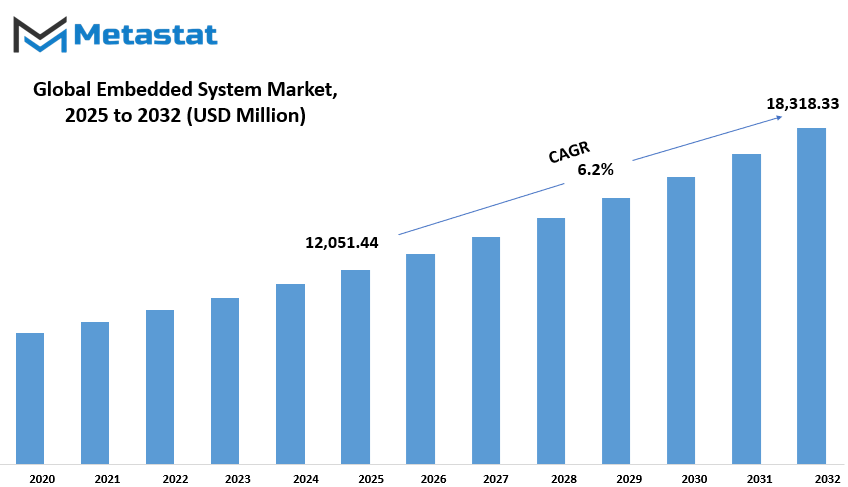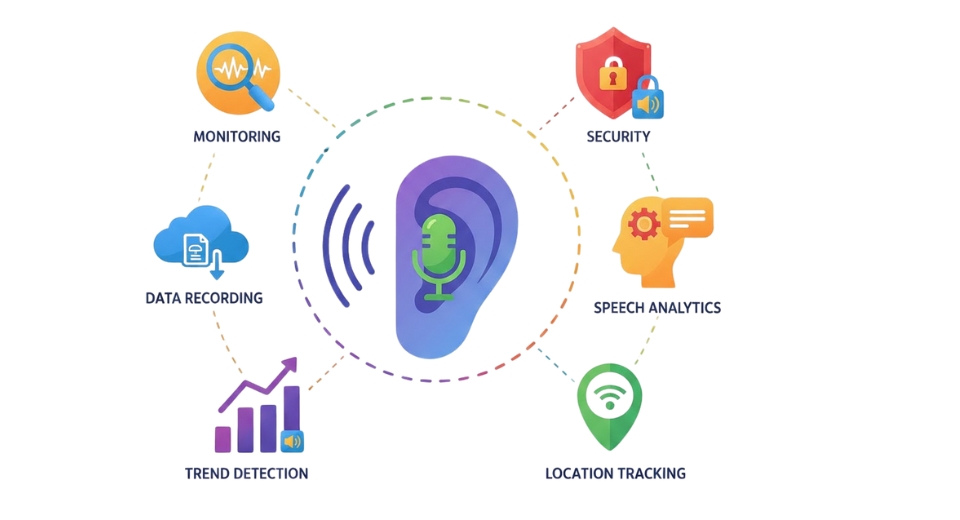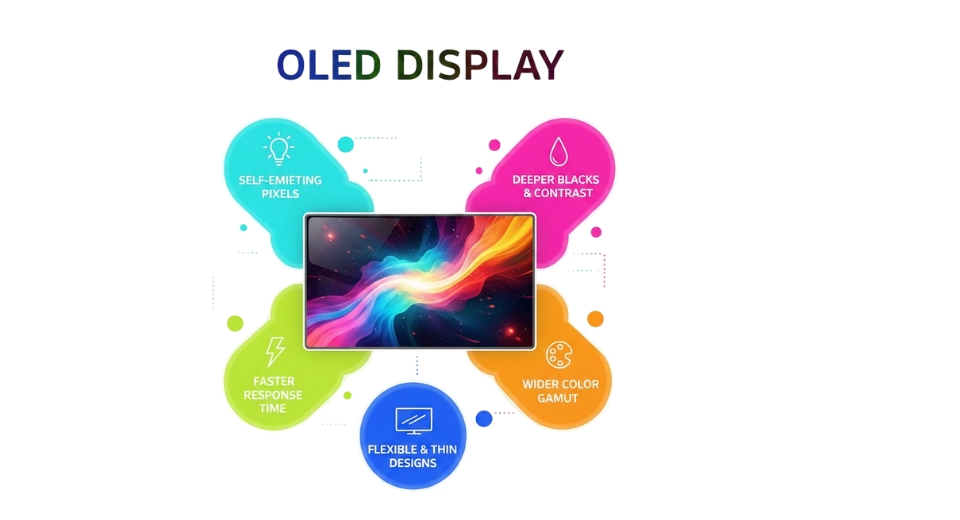MARKET OVERVIEW
The Global Embedded System market is an important paradigm used in running multiple industries. In modern computing, an embedded system is typically designed to perform a fairly independent function efficiently and precisely. Embedded systems are now deeply integrated into the industries such as automotive and healthcare, telecommunications, industrial automation, and consumer electronics, giving a role in seamless functioning. Innovations that would bring embedded systems to the fore of automation, artificial intelligence, and IoT are, in turn, expected to expand their applications in ways never imagined in the past.
The evolution of embedded systems has been vast with technological advancements. Once stuck with simple control functions, these days, such systems exhibit high intelligence, real-time processing, and decision-making. The evolution in the Global Embedded System market started moving from microcontrollers toward high-performance and more capable system-on-chip architectures. Advanced driver assistance systems, electric vehicle management, and infotainment solutions are some examples of automotive applications supported by embedded systems. Patient monitoring, medical imaging, and wearables for health care are also enhanced by embedded systems to allow for improved diagnosis and treatment. Embedded systems contribute to navigation, communication, and security systems in defense and aerospace.
The future of embedded systems is dependent on their ability to mesh with new technologies. The ensuing inbuilt machine learning and AI applications would definitely enhance the decision-making capabilities of the embedded systems, which will have an edge in handling complex data. Another sphere where embedded systems will play a key role is in managing real-time data interchange over interlinked networks with the rise of IoT devices. These would contribute toward making processes in industrial automation even smarter and adapt to real-time conditions.
Embedded systems will ensure that power optimization is prioritized even as industries become greener. Microcontrollers that consume very little power will, alongside energy-harvesting methods, prolong the lifespan of devices, especially for applications involving remote sensors and battery-operated devices. Also, embedded security would be encashed to protect data and communication networks against cyber threats. Enhancing connectivity between embedded devices will now create an avenue for robust security regimes, leading to the increased deployment of encryption and authentication.
The increasing merger of hardware and software improvements is expected to evolve systems into being even more efficient and intelligent looking into the future of the Global Embedded System market. Open-source development frameworks would help to speed innovation in embedded technology, which would then be applicable to various domains. As industries become more automated and digitally transformed, embedded systems will continue to be vital for operational efficiency, reliability, and scalability. The road ahead would also be characterized by intermingling challenges posed by design complexity and integration hitches, but the evolution of embedded technology will be quite speedy to provide solutions for the varying needs of different sectors.
The current trajectory of the Global Embedded System market will be very much dependent on its ability to coordinate with technological changes while keeping them ever more efficient and secure. Embedded systems will thus remain the backbone of modern computing, pushing the frontiers of automation, artificial intelligence, and communication technologies.
Global Embedded System market is estimated to reach $18,318.33 Million by 2032; growing at a CAGR of 6.2% from 2025 to 2032.

GROWTH FACTORS
The global embedded system market shows a decent rate of growth given the sustained advancement of technologies. These days, we are witnessing an increase in the demand for advanced embedded systems due to industrial advancements in different fields. One of the very important aspects driving this growth is the advent of widespread acceptance of IoT and AI-based embedded systems. This is happening at first as industries and users integrate these technologies into their daily applications, making them much more critical applications in healthcare, automobile, industrial automation, and consumer electronics.
The capability of an embedded system to carry smart functionalities and make systems more user-friendly and efficient has, therefore, made them an important subject in technological advancement. The push for automation across industries is aiding the market to grow even faster. Industries are now eyeing automation-from operations to transportation-to improve productivity, reduce errors, and optimize operations, further necessitating embedded solutions.
The demand surge notwithstanding, there are challenges faced by the market. A foremost constraint: high initial development cost. Because specialized hardware and software are required to design and implement embedded systems, the overall costs are highly increased. Besides this is the fact that reliable and efficient systems are incredibly difficult to design and constitute another hurdle.
These two factors together create a huge obstacle for such companies with limited resources. Security and privacy add to the hindrance. Since they are mostly connected devices, embedded devices can be susceptible to attacks. While utmost security measures must be adopted, their implementation only adds more to the development cost and complexity. Therefore, businesses will need to stay on top of those concerns to earn user trust and system credibility.
However, the market has some opportunities for growth. Embedded systems are getting more doors opened in the smart cities and connected infrastructure development. Huge investments are being directed into smart grids and intelligent transportation as well as automated public services, all of which depend on embedded technology. Digitalization is expected to increase demand in the market.
Other new paths will be opened due to fast progress in edge computing and real-time processing. Edge computing enables data processing to occur much closer to the source of that data, thus minimizing propagation delay, and improving efficiency. Adoption of embedded systems in areas where real-time data processing sticks are becoming more accepted will increase further, like healthcare monitoring, autonomous vehicles, and on; industrial automation. Such patterns therefore suggest that despite the challenges at present, the Global Embedded System market has a great potential to grow in the years ahead.
MARKET SEGMENTATION
By Hardware
The Global Embedded System market is critically essential in the technological world, impacting several industries. As technology progresses, embedded systems have gained more efficiency, smaller in size, and wider applications. Integrated hardware and software to accomplish a dedicated task serve as a fundamental element in different sectors of automotive, healthcare, consumer electronics, industrial automation, and telecommunications. Increasing adoption of embedded systems in smart devices, IoT applications, and automation solutions calls for real-time processing and low power consumption.
Hardware accounts for a major proportion in the embedded system market; several components cooperate with each other in the performance and functionality of embedded systems. The Application-specific Integrated Circuit (ASIC) market amounts to $3,362.55 million, indicating the demand for tailor-made hardware solutions that maximize performance and efficiency. Microcontrollers and microprocessors can be found in use in embedded systems: they offer an array of processing capabilities, in relation to application requirements.
PMICs ensure energy efficiency in critical battery-operated devices and industrial automation applications. FPGA deals with flexibility, which means it can be reconfigured at any point, depending on the desired requirements. DSPs do the heavy lifting when it comes to math: algorithm crunching for telecommunications and multimedia processing. Other hardware complements the functioning of embedded systems, thus allowing for all sorts of use case applications across various industries.
Smart technology and automation are gaining traction, and with this, the embedded system market is growing rapidly. Industries concentrate on building advanced solutions to enhance efficiency, security, and performance. Embedded systems in automotive applications are important for advanced driver assistance systems (ADAS), infotainment, and engine management. Embedded technology in medical devices is used for accurate diagnostics and patient monitoring in health care. Smart Consumer Electronics devices - be it smartphones, smartwatches, or home automation systems - rely on embedded systems for seamless operations and connectivity.
Industrial automation applications are enhanced through embedded solutions that promote production efficiencies, minimize downtimes, and enhance safety. This embedded technology can well be defined as network infrastructure that telecommunication uses to achieve fast and reliable communication. Improvement in processing power, energy efficiency, and connectivity will further sink embedded systems into the mainstream of technology developments. Industries are gearing themselves up for research and development efforts toward innovative solutions to meet the needs of specific industrial challenges.
By Software
The embeddable system market will grow as industries incorporate higher technologies across applications. Systems are critical for every appliance from consumer electronics to industrial machines and work efficiently to run these functions and automate their working. The acceptance rate of embedded systems is increasing across industries due to heightened demand for intelligent devices, automation, and connectivity.
Another major characteristic of the prevailing structure of the market is the classification according to the type of software. The market segmentation includes Operating Systems, Middleware, Real-tIme Embedded Applications, Standalone Embedded Applications, and others, based on the classification of embedded software solutions. Operating systems are the software that has the ability to control hardware resources and coordinate the execution of application programs. Middleware is software that allows applications to communicate with and use the services of an operating system in an integrated manner.
Real-time embedded systems are applicable for overseeing processes in which timely response and execution become critical for industries such as healthcare, automotive, and aerospace. While a Stand-alone Embedded Application Independent will operate without relying on an external processor; making it suitable for simpler applications that do not require network connectivity. Other embedded software solutions in this market will cater to specialized requirements of enhancing performance functionality.
Increased acceptance of embedded systems in the automotive, medical, and industrial automation sectors is what accounts for growth in this market. The systems are now adopting some performance, safety, and efficiency enhancement applications, such as advanced driver assistance systems (ADAS) and infotainment applications, as applicable for the automotive industry. These embedded systems aid in the provision of healthcare by allowing real-time monitoring and diagnostics and thus improving patient care. Embedded systems are also being imported into industrial automation concerning smart manufacturing and robotics to be productive and promote operational efficiency.
Emerging IoT penetration shall serve as a prime enabler for embedded systems by serving as a backbone for connected devices. Companies are concentrating more on innovation about making their products more efficient and energy saving. Unfortunately, security threats, high development costs, and compatibility with legacy systems still prevail as challenges. Nevertheless, the ongoing development of software and hardware technologies will assist in the growth of the Global Embedded System Market to the point where it cannot be disassociated from any industrial advancement.
By System Size
The Global Embedded System market is inherently linked into technology that underlies an industry with automation, computing, and control systems as its spinal cords. These embedded systems are fairly efficient because they have been designed to perform a particular function and thus find their applications in areas such as consumer electronics, from the most mundane to the complex and advanced industrial machinery. In fact, with the rise in demand for new smart devices, advances in automotive vehicles, and the growing industrial automation, embedded system technology dramatically influenced society into the optimistic perspective of modern technology. They find their application in medical equipment, telecommunications, aerospace, and home automation.
The market is categorized according to the size of system-type embedded systems into small-scale, medium-scale, and large-scale embedded systems. Small embedded systems support basic applications, e.g., most digital watches, calculators, and even some household appliances. Such systems generally operate using little processing and memory, but they typically perform their very critical functions in an efficient manner.
Medium-scale embedded systems are more specialized, characterized by microcontrollers and microprocessors that execute typical complex functions and applications in a device such as medical instruments, advanced smart meters, and automobile parts arrangements where performance versus cost is crucial. Large-scale embedded systems are sophisticated and often many processors are used with a lot of memory to handle high-performance computing. This is generally employed in advanced industrial automation, telecommunication infrastructure, and aerospace technologies where precision and reliability are paramount.
The market is growing on account of increasing adoption of artificial intelligence, machine learning, and the Internet of Things (IoT), which could eventually make embedded systems smart in processing, real-time decision-making, and increased efficiency in various sectors. The automobile has made strides from the viewpoint of embedded technology: autonomous vehicle function relies largely on embedded systems in ADAS and in-car infotainment systems. Embedded technology is also present in the area of healthcare through diagnostic equipment, wearable health monitors, and robotic-assisted surgeries.
However young and fast progressing, the industry has its problems of high development costs, complexity in design and security issues in particular. Rising connectivity of devices creates a cybersecurity risk, and so it is vital for manufacturers to roll out really secure devices. The market is also continuously powered by innovations in low-power consumption, miniaturization, and real-time processing, even as technology advances. The Global Embedded System market will ever be a significant contributor towards technological evolution to meet rising demands in various industries and further pave the way for smarter, more efficient solutions.
By Application
The Global Embedded System market is a contemporary and extensive area with several applications in various industry sectors. These systems perform specialized tasks within large systems ensuring efficiency, reliability, and interworking. As advanced technologies continue to blend into industries, the demand for embedded systems is set to augment as they improve performance, lower energy, and intelligent automation.
In one of the predominant areas, embedded systems find application in automobiles. Today, automobile safety, entertainment, navigation, and engine control all rely on embedded systems. Airbags, antiskid braking systems, and all these systems to assist in improving vehicle functionality and user experience. Embedded systems would remain the hub of innovation in the automotive sector with the gradual shift toward electric and autonomous vehicles.
Consumer electronics are another significant sector wherein embedded systems find widespread employment. These systems enable smartphones, smart home appliances, gaming consoles, and wearable gadgets to operate seamlessly and possess intelligent features. Technology development will draw further attention toward the improvement of energy efficiency in embedded systems and allow them to perform many difficult tasks without compromising performance.
Embedded systems for the automation, robotics, and control of processes find tremendous application in the industrial field. They enhance the working of the manufacturing unit and production line on the ground of smoothening operations, reducing human intervention, and increasing accuracy. With the increasing deployment of Industry 4.0 and smart factories, embedded systems in enhancing workflow optimization and productivity would see a larger footprint.
Aerospace and defense industries also have mission-critical applications for embedded systems. They find application in supporting avionics, radar, surveillance, and communication networks to ensure operational safety and efficiency. Given the rigorous requirements for reliability and security, embedded systems in this sector are expected to work under extreme conditions with high performance.
Embedded systems find applications in the energy market in areas of power management, grid automation, and renewable energy technologies. These systems monitor energy utilization, optimize distribution, and create avenues for sustainability work. As the world shifts to clean energies, embedded systems are also a major support of efficient energy management.
In the healthcare field, embedded systems have made good contributions. These systems include medical imaging and diagnostic devices, patient monitoring, and life-support equipment, thereby assuring the best possible healthcare services. The AI and internet connectivity in the medical devices will further ensure better patient care and health services.
|
Forecast Period |
2025-2032 |
|
Market Size in 2025 |
$12,051.44 million |
|
Market Size by 2032 |
$18,318.33 Million |
|
Growth Rate from 2025 to 2032 |
6.2% |
|
Base Year |
2025 |
|
Regions Covered |
North America, Europe, Asia-Pacific, South America, Middle East & Africa |
REGIONAL ANALYSIS
Various regions contribute uniquely to the overall growth of the Global Embedded System market. Geographically, the market is segmented into North America, Europe, Asia-Pacific, South America, and Middle East & Africa, each exhibiting its own set of dynamics that affect the growth of this market. North America, for instance, comprises U.S., Canadian, and Mexican markets driven by advancements in technology and a strong industrial base. The region remained dominant, having been one of the first to adopt embedded technologies in automotive, health, and telecommunication sectors.
Europe, the UK, Germany, France, and Italy serve as a very important field in regards to the embedded system application development. In the region, further research and innovation are being carried out, particularly on the automotive and industrial automation front. Germany is best known for its engineering prowess and therefore tops in implementing embedded systems into smart manufacturing processes, while France and the UK utilize these technologies in defense and aerospace applications.
Asia-Pacific contributes to one of the most dynamically growing markets, with major players like India, China, Japan, and South Korea creating major strides on the ground. The electronics and semiconductor industries equally are big contributors while India of late is changing this equation on account of various investments made in smart devices and automation. South Korea equally plays a pivotal role in this region with its advances in consumer electronics and automotive technologies, making great impact on its embedded system market.
Brazil and Argentina are among the frontrunners regarding the adoption of embedded technologies. The regional market is buoyed by demand from sectors like telecommunications, consumer electronics, and automotive. Albeit the rate of adoption has been slower in comparison to other regions, steady growth in the economy with increasing investments in technology is potentially strengthening the market scenario in this part of the world.
In the Middle East & Africa region, including GCC countries, Egypt, and South Africa, the demand for embedded systems in oil and gas, defense, and telecommunications sectors is on the rise. Developing focus on digitalization, smart cities, and automation is fueling market growth in this region. South Africa is stepping in front in the adoption of technology, while GCC states integrate embedded systems into infrastructure and security applications.
Finally, across these regions, technological advancements, specific industrial requirements, and increasing adoption of automation continue to drive the growth of the Global Embedded System market. As industries move towards efficiency and connectivity, embedded systems are increasingly expected to offer major inputs for future innovations.

COMPETITIVE PLAYERS
The future of technology is embedded in the Global Embedded System market in innovative and efficient, as well as compact, solutions for all industries. These systems are developed to perform special tasks with precision and have become another integral element in modern electronic devices. An embedded system is a solution for increased performance and reliability of any application, from consumer electronics to automotive applications, healthcare, and even industrial automation. Embedded systems keep innovating, striving to offer users more efficient solutions applied to diverse sectors with increasing demands for faster and intelligent devices.
Undoubtedly, the market has made significant strides, propelled by technological advancement alongside rising adoption of such systems across industry sectors. These systems have gradually evolved to assume prime importance in telecommunications, smart devices, and automotive applications where they perform tasks that include real-time processing, connectivity, and automation.
The smart cities initiation and the need to interconnect a multitude of devices under the Internet of Things (IoT) has broadened even more the application spectrum of such systems. Comprehensive development of artificial intelligence and machine learning shall make embedded systems more and more sophisticated, enabling them to carry out predictive analytics and have automation in most vital operations.
Some of the significant players of the embedded systems industry are always provided competitive performance improvement and an efficiency level higher than the rest. Intel Corporation, Texas Instruments Incorporated, NXP Semiconductors, Renesas Electronics Corporation, and STMicroelectronics, Microchip Technology Inc., Infineon Technologies AG, Qualcomm Incorporated, Broadcom Inc., AMD, Inc., NVIDIA Corporation, Tessolve, and Avench Systems are some of the representatives of the embedded systems industry.
These companies play a crucial role in incubating, researching, and developing the advanced solutions they manufacture to meet the increasing industry other demands from certain sectors relying on these embedded technologies. Consequently, increased benefits accrue in terms of power efficiency as well as processing speed and security features.
As a result of the competitive advantages they offer, embedded systems have a market that presents design complexity challenges as well as integration issues, coupled with the demand for higher reliability. This long process of embedded system development needs ample qualifications and sufficient continuation improvements to run applications smoothly. Moreover, network embedding may expose systems to several possible cyber threats; thus, security is also a hurdle. Continuous strides in improving hardware and software solutions are being made to counter all of these emerging issues.
Embedded System Market Key Segments:
By Hardware
- Application-specific Integrated Circuits (ASIC)
- Microcontrollers
- Microprocessors
- Power Management Integrated Circuits (PMIC)
- Field Programmable Gate Arrays (FPGA)
- Digital Signal Processors (DSP)
- Other
By Software
- Operating Systems
- Middleware
- Real-time Embedded Systems
- Standalone Embedded Systems
- Other
By System Size
- Small-scale Embedded Systems
- Medium-scale Embedded Systems
- Large-scale Embedded Systems
By Application
- Automotive
- Consumer Electronics
- Industrial
- Aerospace and Defense
- Energy
- Healthcare
- Communication
Key Global Embedded System Industry Players
- Intel Corporation
- Texas Instruments Incorporated
- NXP Semiconductors
- Renesas Electronics Corporation
- STMicroelectronics
- Microchip Technology Inc.
- Infineon Technologies AG
- Qualcomm Incorporated
- Broadcom Inc.
- Advanced Micro Devices, Inc.
- NVIDIA Corporation
- Tessolve
- Avench Systems
WHAT REPORT PROVIDES
- Full in-depth analysis of the parent Industry
- Important changes in market and its dynamics
- Segmentation details of the market
- Former, on-going, and projected market analysis in terms of volume and value
- Assessment of niche industry developments
- Market share analysis
- Key strategies of major players
- Emerging segments and regional growth potential








 US: +1 3023308252
US: +1 3023308252






